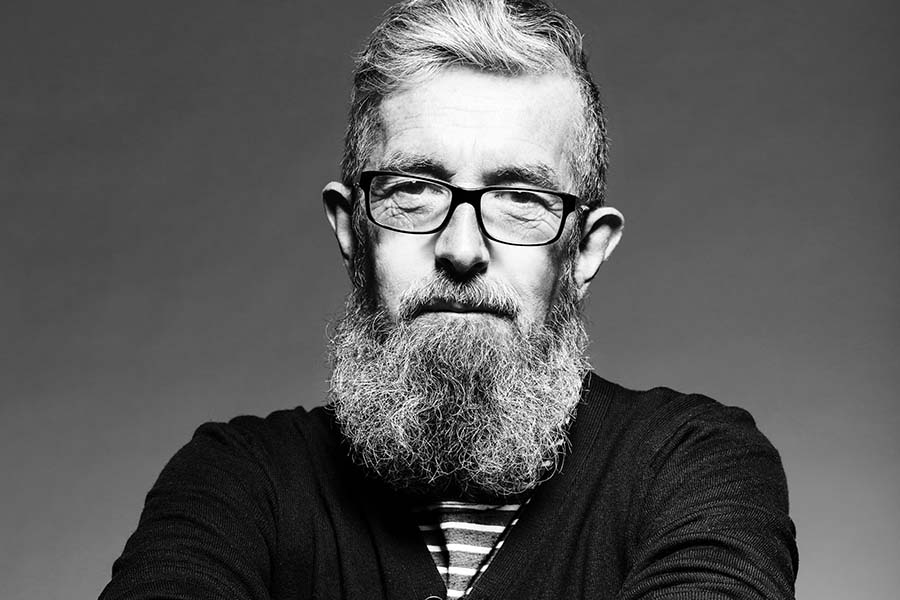When the lights went out in March 2020, theatre people had no idea how much time was being dumped in their laps. The initial uncertainty around COVID was paralyzing, but gradually, long before the death toll got scary and the economic hardships got serious, more and more of us came up with pandemic projects large and small that might only have ever happened during life under lockdown. Les Waters and I decided to make a book.
For the past 25 years, Les Waters has conducted a directing career at the heart of the American theatre. He has staged Shakespeare, Sheridan, and Shaw as well as American classics by O’Neill, Wilder, Williams, and Shepard, but he is best known for his work with some of the nation’s more adventurous contemporary playwrights, including Sarah Ruhl, Charles Mee, Naomi Iizuka, Will Eno, Anne Washburn, and in recent years Lucas Hnath. That work helped to earn him an Obie Award in 2020 for Sustained Excellence in Direction that recognized “his ease with both the delicate and the spectacular,” “his mastery of the borderlands where emotion and reality are equally slippery,” and “his significant collaborations with actors and designers and his advocacy for new writers and young directors.”
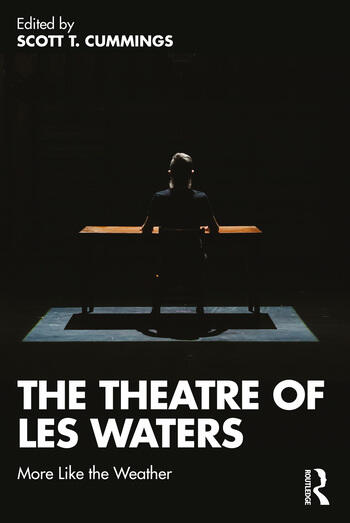
Waters has been head of the MFA directing program at UCSD, associate artistic director at Berkeley Repertory Theatre, and artistic director of Actors Theatre of Louisville, a position he left after six years in 2018 to pursue freelance projects. One of the more successful of those is Dana H., Lucas Hnath’s one-character play, in which veteran actor Deirdre O’Connell lipsyncs a lengthy verbatim text based on interviews with Hnath’s mother Dana Higginbotham about a harrowing kidnapping experience. After runs at Center Theatre Group’s Kirk Douglas Theatre in Los Angeles and the Goodman in Chicago, Dana H. had just opened at the Vineyard Theatre in New York when COVID shut down theatres nationwide. But, thanks in part to Waters’s subtle direction and O’Connell’s stunning performance, the production had not run its course. It was one of the first shows to be revived as theatres gradually reopened in the fall of 2021, running on Broadway at the Lyceum Theatre for six weeks in rep with Tina Satter’s Is This A Room. Waters was later nominated for a Tony Award for his direction, and O’Connell and sound designer Mikhail Fiksel both received Tonys for their work.
Waters has remained relatively busy since theatres came back online. He directed two productions at Berkeley Rep: Charles Mee’s Wintertime and a new production of Dana H. with Jordan Baker in the challenging title role. He conceived and directed Out of Time, a suite of five 30-minute monologues written by five Asian American playwrights for five Asian American actors over the age of 60, produced by NAATCO at the Public Theater earlier this year. More work lies ahead. There are developmental workshops with David Cale, Lucas Hnath, and Naomi Iizuka, and Martha Redbone. Next summer, he will direct Pinter’s No Man’s Land at Steppenwolf with Austin Pendleton and Jeff Perry. And if all goes according to plan, Waters will have a sublime full-circle moment early in 2024 when he directs Dana H. at the Royal Court Theatre, right where his career started in 1979 as artistic director of the Royal Court’s experimental studio, the Theatre Upstairs.
Waters was a few weeks past his 68th birthday in April 2020 when he reached out to me about an idea that I had first broached with him years earlier. Over that first pandemic summer, between Berkeley and Boston, we spoke on the phone multiple times a week about his life, career, and perspective as a director. Those recorded conversations provided the raw material for what became The Theatre of Les Waters: More Like the Weather, a mosaic of short writings (including a dozen lists) that aim to capture what makes Waters the theatre artist that he is, and by extension what makes a good director. Collaboration, of course, is central to a director’s practice, so to capture that dimension we recruited two dozen of Waters’s colleagues over the decades—playwrights, designers, dramaturgs, stage managers, and former students—to write essays describing their work together.
Here are a few excerpts from the book, all composed by Waters and edited by me, that suggest something about who Waters is and our impressionistic strategy for creating the book’s portrait of him and directing itself.
Early Theatre Experience
I don’t remember any HA!! moment when I thought, This is it, I know what I’m going to be, I’m going to be a theatre director. I can remember exactly where I was when I decided I was an atheist but not a director. Both choices involved long walks through local woods on Sunday afternoons as a brooding teenager. The decision to reject God and Christianity was a form of shattering. With directing I started walking and many miles later I arrived back home a director.
I don’t remember any HA!! moment when I thought this is it, I know what I’m going to be, I’m going to be a theatre director. I can remember exactly where I was when I decided I was an atheist but not a director. Both choices involved long walks through local woods on Sunday afternoons as a brooding teenager. The decision to reject God and Christianity was a form of shattering. With directing I started walking and many miles later I arrived back home, a director.
The first show I ever saw was the panto Dick Whittington and His Cat at the theatre in Cleethorpes (I was born there) one Christmas. Going to the theatre was a major event. We couldn’t afford the theatre. We couldn’t afford much of anything. I remember cats dancing on the roofs of London at midnight and it was snowing. I was 3, maybe 4, and slightly scared of the whole thing, and was sitting on my grandpa’s lap and I thought the cats were real and I thought I want to make things like that. It was that clear. But I was 3. Then it’s a blank till my last two years at grammar school, and by then I knew that I needed to be in the theatre and I didn’t want to be an actor. Being looked at can be difficult for me and that tends to be a major stumbling block for any performer. I was very influenced by two teachers: Enid Pittwood, who taught history and directed the school play, and Jim Hawkins, who taught English and made events with the students. He introduced me to John Arden and the work of the Royal Court. So by my junior year at high school I was regularly disappearing to London to see plays.
I was a teenager in the 1960s. Everybody knew something big was going on and it wasn’t going on in the town where I was growing up. I became involved with the Scunthorpe Youth Theatre. Mike Bradwell—who started the theatre group Hull Truck and was close friends with the film director Mike Leigh and went on to run the Bush Theatre—was from the same area as me. And he directed a production of John Whiting’s The Devils in Scunthorpe one summer. Quite a radical choice for a youth theatre. But it was the ’60s. I played Cardinal Richelieu. I think I had one scene and I don’t remember anything that I said. I must have been 15 or 16. It was amazing. We were a bunch of arty, snotty, deeply opinionated teenagers, and Mike would say, you should listen to this music, or you should read this, or there’s a play by so-and-so, or you have to see the work of this director. I remember lying in a medieval sarcophagus in Thornton Abbey graveyard at midnight and believing, this was improvisation. I remember listening to Pink Floyd’s A Saucerful of Secrets at all hours of the day and night, waiting for revelation. My world suddenly became more expansive and more interesting. A sense of connection to an imaginative universe.
Theatres I Have Known
The Royal Court Theatre, London. Proscenium. A wonderful relationship between the stage and the auditorium. Epic in an intimate way. So many memorable productions: Max Stafford-Clark’s Top Girls, The Glad Hand, Bill Gaskill’s The Sea, Nancy Meckler’s Curse of the Starving Class, Peter Gill’s Small Change, Ian Rickson’s Mojo.
The Almeida, London. What was the original function of the space? A meeting hall? A warehouse? Its curved brick back wall. Its height. Its intimacy. The sense of being inside the production with the performers. Joint Stock’s production of Fen opened here in February of 1983. A frigid winter. No heating. Seeing the actor’s breath on stage.
The Traverse Theatre, Edinburgh. I’m thinking of the old Traverse in the Grassmarket. I’m not sure I even remember the space with any clarity. I do remember interviewing on two occasions for the position of artistic director and being rejected. A numbing heartbreak at the time. I feel that my career would have been very different if I had been accepted. “Career” makes me cringe. Sounds like something planned, something well thought out. Now, I did want to work at the Royal Court. And I did want to work in the States. And I achieved both things. I have had a life. I am having a life. I don’t want to say “a life in the theatre” because that is so luvvie. And also a David Mamet play.
(The challenge in writing this list is that it is about memory. I intended to write about physical space. Or mostly about that. But it’s become very quickly about my emotional connection to the space/theatre. I directed one show at the old Traverse. Rona Munro’s Fugue. I remember so little about the play. I don’t remember the design at all. I don’t think it was a “bad” production. But the experience of being there working on that show is firmly lodged in my mind. Traverse/Fugue/Edinburgh/artistic director interviews/disappointment. Proust and his madeleine.)
The Public Theater, New York City. I’ve seen shows in all of the spaces there and worked in the Newman, the Anspacher, the LuEster, and the Shiva. My American career (that word again!) started here with Fen in 1983. I didn’t really know how important the institution was. Joe Papp, his generosity, his cruelty. My youth, my self-importance. I can’t really describe the actual spaces and how they work. Like being inside a monument, a monument called the Public Theater.
The Roda Stage, Berkeley Rep, California. The larger of the two stages. The proscenium. I understand prosceniums. The disconnect between the seats downstairs and the seats upstairs. Too separate experiences. No wing space. Wide enough to feel epic. And yet two people standing on that stage in its emptiness can feel intimate. I love working there: Fetes de la Nuit, In the Next Room, The Lieutenant of Inishmore, Concerning Strange Devices from the Distant West. I think of this place as a home.
Soho Rep, New York City. I have probably seen more productions here than any other theatre in New York. I love what they do. Sarah Benson. Hero. It’s small, it’s cramped, it shouldn’t work but it does. It transforms. I have seen great plays here—Branden Jacobs-Jenkins’s An Octoroon, Fairview by Jackie Sibblies Drury, Is God Is by Aleshea Harris—in great productions, but the place sings design to me. I think of Soho Rep as design. The transformation of space. Think Louisa Thompson for Blasted, David Zinn for 10 Out of 12, Mimi Lien for both An Octoroon and Fairview. Geniuses. Heroes.
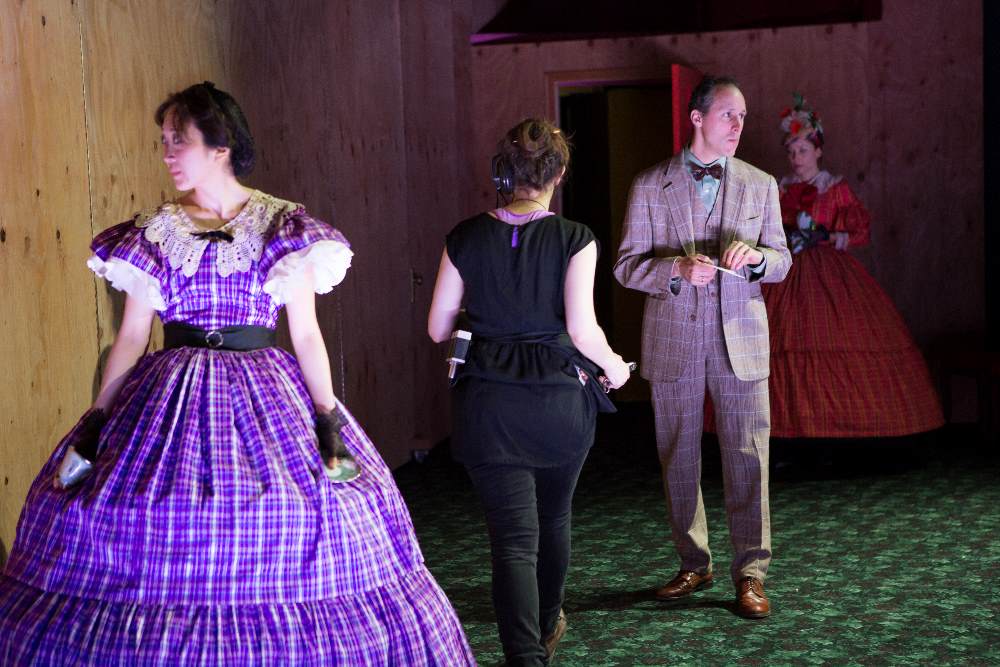
The Lyceum Theatre, Broadway, NYC. Where the good people at Lincoln Center produced The Vibrator Play. Perfect alignment of play, design by Annie Smart, and theatre. A play set in the Victorian era living in a Victorian theatre. I don’t like watching my own work—I know that is a problem—but I was happy sitting in those cramped seats amongst a puzzled audience watching this. During the many weeks of previews I got to know the space well. I watched from up top and loved the layers of velvet dust on the sculptures. I watched from the wings, and when I couldn’t watch anymore I listened to the show from the dressing room within the proscenium arch itself. A magical place.
Brooklyn Academy of Music. Beautiful. Important. Honored to have had two shows in the Harvey. Both by Chuck Mee. Both originating from ATL. Big Love and Glory of the World. That space carries the spectacle of the work as if it’s a head on a silver platter. I’ve watched amazing productions there: Ivo’s Opening Night, the dance pieces of Pina Bausch and Susanne Linke. Joe Melillo. Hero.
Actors Theatre of Louisville. I’ve worked in all three spaces—the Pamela Brown, the Bingham, and the Victor Jory—and in an abandoned warehouse in Butchertown. My involvement with ATL began with Big Love in 2000 and ended with The Thin Place in 2019. I was AD from 2012 to 2018. Not so much the performance spaces as the rehearsal room, the Humana Room on the 5th floor of the administrative offices on Market Street—that says Actors Theatre to me. It’s not run-down and seedy like so many rehearsal rooms. It’s crisp with a little bit of battered. It’s not large enough to accommodate the width of the Pamela Brown. It’s not deep enough either. The AC system is quixotic. It has fluorescent lighting and it has windows. It can be quiet. And it doesn’t feel isolated. For six and a half years I both made theatre and watched others make theatre in that space. I’ve watched discoveries and meltdowns and revelations about plays and performance that can never be recreated. I have had seizures in that room. It is a perfect space. A space of endless possibilities.
La Fenice, Venice, Italy. I’ve never been to Venice, I’ve never been to Italy. To be honest, I’m not really sure what the space is like. The name calls out, though. La Fenice.
A Good Rehearsal Room
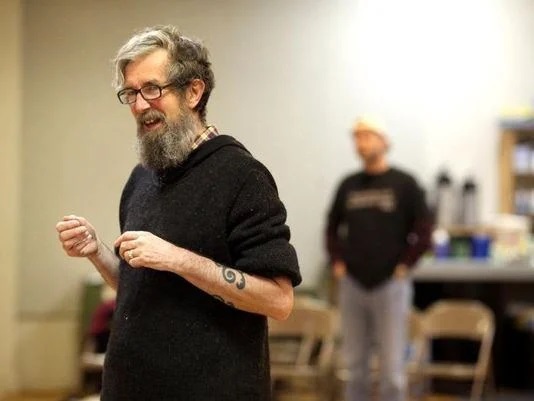
Somewhere that is part of the theatre and not miles away.
Somewhere quiet.
Somewhere where people can enter quietly.
Somewhere with good lighting.
(Sitting under fluorescent light all day is not good.)
(Staring through a window at the sun all day is not good.)
Somewhere above ground.
(I don’t want to have to join the Miner’s Union in order to work.)
Somewhere the same size as the playing area of the stage.
Somewhere I trust everybody I am working with.
Somewhere where everybody has an appetite for the project.
Somewhere with an endless supply of coffee.
Somewhere we can fail and nobody will snicker or titter or roll their eyes.
Somewhere I feel safe and there is a sense of possibility in the room.
Thin Places
My mother’s family in Lincolnshire were farm laborers, sometimes servants in the big house, very Methodist, and deeply superstitious. You couldn’t bring certain flowers into the house at certain times of year. You couldn’t cut your toenails on a Sunday or the devil would get you. A spirit of some sort called Raw Head and Bloody Bones lived under the stairs in my grandparents’ house. The Wesley brothers, who founded British Methodism, were from Epworth near Scunthorpe where I was brought up. Methodism was very strong in my family. I spent a lot of time with my maternal grandparents growing up. I remember them as storytellers. They were first generation town dwellers and would tell stories of what it was like in the village where they were born. I thought they were living history.
My Grandma Carrie would talk about thin places. I am an only child but I am the youngest and the smallest—I stand at 6′ 2″ now—of four male cousins. I was the little one, the baby. We never really knew what the term meant and it was probably her way of keeping us in line, but there were these thin places and she would warn, “Leslie, if you go there, you’re going to be in trouble.” A thin place is where the membrane or boundary between this world and some other world—I have often mistakenly said between this world and the next world, but it definitely wasn’t the next world—is very thin. And you could slip between one and the other. There was a thin place in a field close to the village where my grandparents were born. Kirmington, Lincolnshire. It has a population of about 300. We were told to keep away from there because it was dangerous. And why it was, I don’t know. Maybe somebody disappeared there a hundred years ago. I don’t know. I have no information.
I lived the first 18 years of my life at 30 Lincoln Gardens in Scunthorpe. And at the corner of Lincoln Gardens and Laburnum Grove, there is a tree. Not a big tree. A medium-sized, rather scrappy-looking tree. And that tree, for years I believed, walks at night. I sound like a Thomas Hardy novel when I talk about this. But that tree walks at night and it’s not wise to walk by that tree late at night.
It made an impression on me as a child. These places where you could walk through and be in some other world. But what horrified me as a child is that something from that other world could pass through into this one and grab me and take me back. What the other world was, I don’t know. At one point I imagined it as a thick wet fog. I was worried by thin places as a kid and then I forgot about it, or it turned into yet another strange story about my mother’s family’s rural life.
When we were workshopping Dana H. at the Goodman, Lucas said he wanted the play to change gears very suddenly, for something to happen that was unexpected that shifted the play into different territory. And I said, “Oh, it sounds like a thin place.” I explained it to him. And he thought it was an interesting title for a play, and then there was a play called The Thin Place.
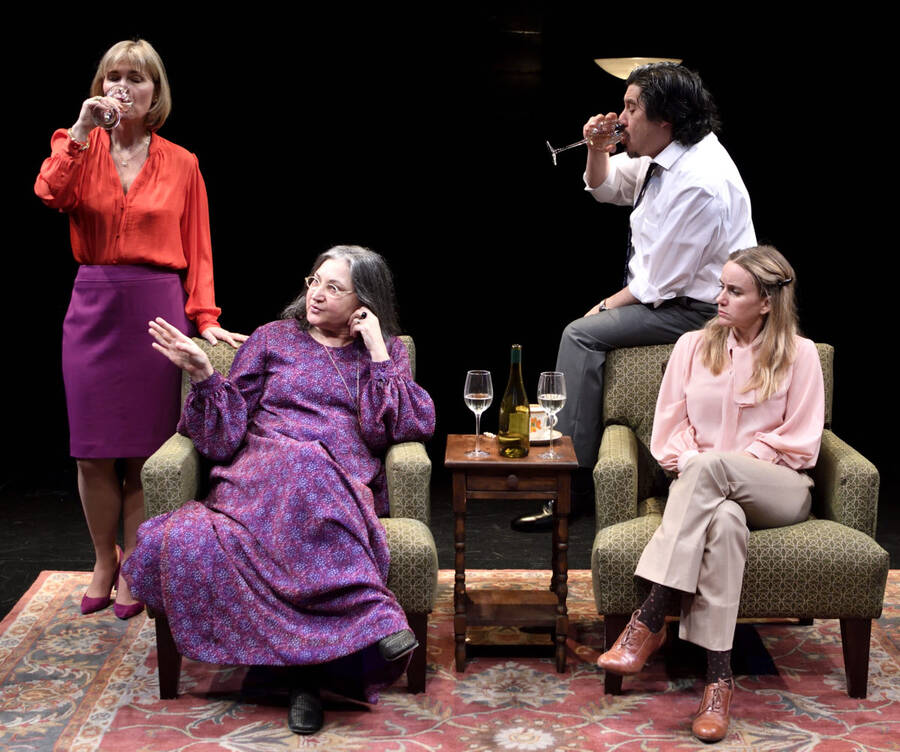
Do I experience it personally? Thin places? I don’t know. In some way it may be tied to my epilepsy. Or is it a way for me to visualize my epilepsy? I don’t know what happens to me during a seizure. I have no memory of the event. Or when I have a memory of it, is it because I am reconstructing something that other people have told me? Am I unconscious during a seizure, or am I in some other consciousness? I have a notion that I’ve gone somewhere else. But I have no knowledge of where that somewhere else is. I have gaps in my memory that are bigger than the actual event. The seizure could be only two or three minutes long, but it may eradicate several hours of memory. So there could be a three-hour gap and then I find myself sitting in a chair having a cup of tea talking to people telling them I’m all right, asking can they get me home and I have a terrible headache and do they have something for it.
And everything else has been erased. Or rather there’s a very, very faint blur of the experience somewhere. As if I had drawn or written out the experience on a sheet of paper and then I or my rogue neurology had erased it. Maybe this is what attracts me to Rauschenberg’s “Erased de Kooning Drawing” in the San Francisco Museum of Modern Art. Rauschenberg asked the Abstract Expressionist painter Willem de Kooning—near the height of his fame—for a drawing and then he erased it and put it in a gilded frame. I could look at it for hours. For hours. I am fascinated by the traces of things. I find the idea of destroying something—the idea that the destruction of one thing is the act of making something else—profoundly interesting. Its blankness is compelling.
Opposites
I am addicted to opposites. To be precise, I am addicted to the space between opposites. It’s important to look between the opposites, at the space between two things. I have an acute sense of contradiction. I love contradiction in a production. I like queasy ground. I like things that are porous and travel back and forth between two poles. That intrigues me. I have always thought that everything was double-sided. That everything contains its reverse. And because I don’t appreciate being told what to think, I need to keep the opposite spinning all of the time.
My maternal grandparents, Carey and Charles, were working-class socialists. I don’t think they ever sat me down as a child and said, “You need to understand the principles of Hegelian dialectics.” But when I did, I thought, “Thesis? Yes! Antithesis? Absolutely! Synthesis? Really? I’m not convinced.” I don’t believe that things resolve. Ever. I just don’t believe it. I like change. I like the possibility of change. Cozy ideas of resolution and closure make me crazy. Change is the only constant. Productions should end with a big series of question marks. Shouldn’t they?
Here’s a favorite quote:
I hate endings. Just detest them. Beginnings are definitely the most exciting, middles are perplexing, and endings are a disaster. The temptation towards resolution, towards wrapping up the package, seems to me a terrible trap. Why not be more honest with the moment? The most authentic endings are the ones which are already revolving towards another beginning. That’s genius.
—Sam Shepard, The Paris Review
Released in April, The Theatre of Les Waters: More Like the Weather is available from Routledge/Taylor & Francis group.

